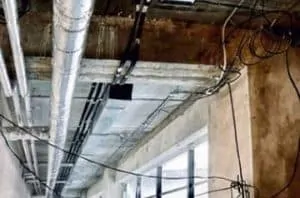

SCS has completed numerous mold surveys for a variety of facilities, such as schools, offices, warehouses, industrial, and commercial buildings. We do not recommend a mold survey if you observe mold — if you can see it, you have a mold issue. Mold is ubiquitous and requires water and food to grow, so if you observe mold growth, the first step is to stop the source of water.
Exposure

There are no promulgated governmental exposure limits for mold, as every individual responds differently to the presence of mold. Mold surveys are typically performed after the water leak has been repaired, and the water damaged building materials have been replaced. This post-remediation survey lets you know if the cleanup has been successful and the area is safe to occupy.
If tenants are complaining of moldy or musty odors, a survey can tell you if you have a mold problem even if there is no visible growth. Mold can be present inside walls, air ducts, and false ceilings, behind cabinets, beneath flooring, for example. Successful survey results will show lower levels of mold spores inside the building compared to the outside sample results, with low to absent levels of concern.
Survey Process
SCS performs indoor air quality or IAQ, mold surveys using the newest battery-powered Zefon Bio-Pump® Plus, which collects an air sample for mold analysis in as little as 5 to 10 minutes, with an auto-shutoff feature once the sample is collected. Typically, a minimum of six samples are recommended, three inside and three outside, with the total number of samples dependent on the size and complexity of the affected area.
We transport the sample cassettes to a certified laboratory under the chain-of-custody protocol for mold spore analysis, with results typically available within 2 to 5 days. Rush analysis is available for an additional cost (same day service is dependent on the time of sample delivery to laboratory). Laboratory analytical reports may include spore counts for approximately 20 types of mold, total count comparisons; background count comparisons; explanation of results with descriptions of the individual spore types; references, and informational links.
Costs
Typical costs for a mold survey range from $2,500 to $10,000, depending on the location, size, and complexity of the survey area. As soon as the review of the laboratory report is complete, SCS provides verbal results, with a technical report typically issued within 10 business days of receipt of laboratory data. Most mold inspection firms utilize technician level workers. Having oversight by a certified industrial hygienist, SCS ensures the most complete and comprehensive survey appropriate to the needs of landlords and owners of commercial buildings and multi-residential dwellings.
If you’d like more information or have questions, please contact Jed Douglas, CIH, CSP, PG, Senior Project Advisor at SCS Engineers, or contact SCS at for an Occupational Health and Safety professional nearest you.
Mr. Douglas is a Senior Project Advisor specializing in Occupational Health and Safety Programs. He is a Certified Industrial Hygienist (CIH), a Certified Safety Professional (CSP), a licensed Professional Geologist in California, Oregon, Washington, and Arizona, and a U.S. Green Building Council LEED Accredited Professional. He has over 25 years of experience as a health and safety specialist and senior project manager, and has managed numerous environmental projects involving safety; soil and groundwater investigations and remediation of hazardous constituents; and, indoor air quality (IAQ) assessments for physical, chemical, and biological contaminants.